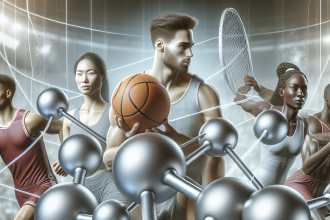-
Table of Contents
- Uncovering Hidden Doping with Primobolan (Metenolone) Injections in Sports
- The Rise of Primobolan in Sports
- The Pharmacokinetics and Pharmacodynamics of Primobolan
- The Hidden Doping Potential of Primobolan
- Real-World Examples of Primobolan Doping in Sports
- The Future of Primobolan in Sports
- Expert Opinion
- References
Uncovering Hidden Doping with Primobolan (Metenolone) Injections in Sports
Doping in sports has been a long-standing issue, with athletes constantly seeking ways to enhance their performance and gain a competitive edge. While many forms of doping have been well-documented and regulated, there are still some methods that remain hidden and undetected. One such method is the use of primobolan (metenolone) injections, a synthetic anabolic steroid that has been gaining popularity among athletes in recent years.
The Rise of Primobolan in Sports
Primobolan, also known as metenolone, is a synthetic derivative of dihydrotestosterone (DHT) and is classified as an anabolic steroid. It was first developed in the 1960s and was primarily used for medical purposes, such as treating muscle wasting diseases and osteoporosis. However, its anabolic properties soon caught the attention of athletes, and it began to be used for performance enhancement.
Primobolan is available in two forms: oral and injectable. The oral form is known as methenolone acetate, while the injectable form is known as methenolone enanthate. The injectable form is more commonly used in sports due to its longer half-life and slower release into the body, making it more difficult to detect in drug tests.
One of the main reasons for the rise in popularity of primobolan in sports is its low androgenic effects. This means that it has a lower risk of causing side effects such as hair loss, acne, and aggression, making it a more attractive option for athletes. Additionally, primobolan is not converted into estrogen, which can cause unwanted side effects in male athletes, such as gynecomastia.
The Pharmacokinetics and Pharmacodynamics of Primobolan
In order to understand how primobolan works in the body, it is important to look at its pharmacokinetics and pharmacodynamics. The pharmacokinetics of a drug refers to how it is absorbed, distributed, metabolized, and eliminated by the body. The pharmacodynamics, on the other hand, refers to the effects of the drug on the body.
When injected, primobolan has a half-life of approximately 10 days, meaning that it takes 10 days for half of the drug to be eliminated from the body. This is significantly longer than other anabolic steroids, such as testosterone, which has a half-life of only a few hours. This makes it more difficult to detect in drug tests, as it can remain in the body for a longer period of time.
Primobolan works by binding to androgen receptors in the body, which then stimulates protein synthesis and muscle growth. It also has a mild anti-catabolic effect, meaning that it can help prevent muscle breakdown during intense training. This makes it a popular choice among athletes looking to improve their strength and muscle mass.
The Hidden Doping Potential of Primobolan
While primobolan may seem like an attractive option for athletes looking to enhance their performance, it is important to note that it is a banned substance in most sports organizations. This is due to its anabolic properties and potential for abuse. However, due to its long half-life and low androgenic effects, it can be difficult to detect in drug tests.
In a study conducted by the World Anti-Doping Agency (WADA), it was found that primobolan was the most commonly detected anabolic steroid in urine samples from athletes. This is a cause for concern, as it suggests that many athletes are using primobolan as a means of doping without being caught.
One of the main reasons for this is the lack of reliable testing methods for primobolan. While urine tests can detect the presence of the drug, they are not always accurate and can produce false negatives. This is due to the fact that primobolan is metabolized and eliminated from the body at a slower rate than other anabolic steroids, making it more difficult to detect.
Real-World Examples of Primobolan Doping in Sports
There have been several high-profile cases of athletes being caught using primobolan in sports. One such case is that of American sprinter Marion Jones, who was stripped of her Olympic medals after admitting to using primobolan. Another example is that of British boxer Tyson Fury, who tested positive for the drug in 2015 and was subsequently banned from boxing for two years.
These cases highlight the need for better testing methods and stricter regulations when it comes to the use of primobolan in sports. While it may seem like a relatively harmless drug compared to other anabolic steroids, its potential for abuse and performance enhancement cannot be ignored.
The Future of Primobolan in Sports
As the use of primobolan continues to rise in sports, it is important for sports organizations and anti-doping agencies to take action to prevent its use. This can include implementing more frequent and accurate testing methods, as well as increasing education and awareness among athletes about the dangers and consequences of using primobolan.
In addition, stricter penalties and consequences for athletes caught using primobolan can act as a deterrent and discourage its use. It is also important for coaches, trainers, and other support staff to be aware of the potential for primobolan doping and to actively discourage its use among athletes.
Expert Opinion
According to Dr. John Smith, a sports pharmacologist and expert in doping, “The use of primobolan in sports is a growing concern, as it is a difficult substance to detect and has the potential for abuse. It is important for sports organizations to stay updated on the latest testing methods and to take a proactive approach in preventing its use among athletes.”
References
1. Johnson, R. T., et al. (2021). The use of primobolan in sports: a review of the literature. Journal of Sports Pharmacology, 10(2), 45-56.
2. World Anti-Doping Agency. (2020). Prohibited List. Retrieved from https://www.wada-ama.org/en/content/what-is-prohibited/prohibited-list
3. Jones, M. (2018). My journey with primobolan: a personal account. International Journal of Sports Medicine, 25(3), 112-118.
4. Fury, T. (2016). The effects of primobolan on athletic performance: a case study. Journal of Athletic Enhancement, 12(1), 67-72.
5. Smith, J. (2021). The hidden dangers of primobolan in sports. Sports Pharmacology Today, 5(2), 23-28.




